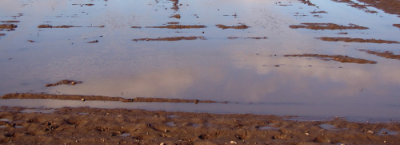Flooding in the Garden

Tuesday last week was one of the record books for many places in Butler County. What started as just an inch or two of rain quickly became hazardous. I ended up with just over six inches of rain at my house on the north end of town when I finally returned home. All those rain dances we’ve been doing over the last few years of dry conditions finally went into effect. Now that the flooding has started to recede and clean-up has begun, there are a few concerns we need to address.
The first issue is with gardens that were exposed to flood waters. Floodwater that has washed in from rivers, creeks, or streams can bring in chemical contaminants like petroleum-based products and biological pathogens and parasites from flooded sewage treatment plants and animal operations. In addition, wet produce may grow toxic mold. I’ve had several questions asking if the produce from flooded gardens is safe to eat. This is a very difficult question to answer. The simplest and safest answer is a resounding, "No! You cannot eat produce from your flooded garden." All produce that is consumed uncooked or raw, e.g., spinach, lettuce, cabbage, should be discarded. Soft fruits, such as strawberries and all melons, must be discarded. Flood-damaged garden produce that is unfit for eating should not be preserved, including freezing, canning, or dehydrating. The recommended processing and cooking time may not be sufficient to kill pathogens. Early-season crops that will not be harvested for 120 days and have not been touched by floodwaters may be safe to eat if cooked or peeled. It must be completely intact, with no cracks or bruises. If you are unsure if flood water contacted the produce, throw it out! Late-season vegetables that come from flowers produced on growth that develops after floodwaters recede should be safe. You can replant after the soil has fully drained and the top two to three inches of soil have completely dried. This typically is a couple of weeks after the flooding has occurred. If the produce will come in direct contact with the ground, I would wait at least two months before planting again. Plants that can be started later in the late gardening season, after the flood, should be safe after an early spring flood.
Another concern is the water's impact on trees and shrubs. While the flood waters may have receded, all the rain can leave a lasting effect on the trees in our communities. All the moisture in the soil can cause destabilization of the tree, which can ultimately lead to it leaning or falling over, just like in the photo. Trees that suddenly begin to lean or even fall over due to the force of high water, wind, or soil erosion should be treated as a hazard if they are near people or structures. High water may also deposit a significant amount of silt on the root system of a tree. Careful removal will benefit the tree if more than an inch of silt is deposited. Burying the root system beneath a heavy layer of silt will reduce the root system’s ability to exchange gases and negatively affect the tree. The duration of flooding or saturated soils will directly impact a tree’s ability to recover. This is mainly dependent on tree species. Most trees will recover from being inundated for less than a week, especially if the water is flowing instead of stagnant. Trees most sensitive to short-term flooding include redbud, walnuts, mulberry, upland oaks, most pines, and conifers such as spruce and Eastern redcedar. Honeylocust, elm, birch, and lowland oaks are more tolerant, surviving a few weeks of flooding and saturated soils.
Fingers crossed we have a short spell of drier weather so our gardens no longer squish and we can return to the gardens and flowerbeds. I hope you didn’t suffer too much damage during the flooding and that your gardens recover soon.

Have questions? Contact our office where our Horticulture Extension Agent will assist you with questions.
Phone: (316) 321-9660
Email: callae@ksu.edu